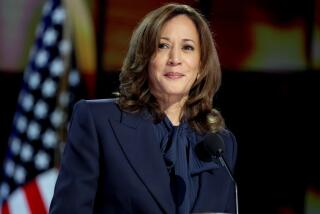How Conventions Lost Their Spark
- Share via
Will this month’s political gatherings in San Diego and Chicago be remembered as the last of the four-day conventions? Network television executives, pointing to poor ratings, are lobbying for more compact proceedings. But host cities, who pour millions of dollars to gear up for the conventions but then expect them to generate even more in business, can be expected to resist such a move. Here is a look at how U.S. political conventions have evolved:
1836: Democrats convene the first convention, taking the nomination process away from party office-holders. For the rest of the 19th century and well into the 20th, conventions were frequently raucous, unpredictable affairs.
1936: The Democrats do away with their rule requiring a two-thirds vote among delegates for the nomination, reducing the likelihood of multi-ballots.
1952: Dwight Eisenhower’s wins in the handful of states then holding primaries help him capture the GOP nomination, demonstrating the momentum such victories could provide. The year also marked the start of what would quickly become gavel-to-gavel television coverage of conventions.
1960: The growing importance of primaries is confirmed when a win by John F. Kennedy in West Virginia effectively clears the field for him.
1968: Hubert H. Humphrey left many Democrats frustrated when, with the backing of party leaders, he was nominated at the tumultous Chicago convention even though he had not fared well in several major primaries. Rule changes embraced by both parties ultimately turned the nominating process almost entirely over to primaries.
1972: A chaotic Democratic conclave--nominee George McGovern gave his acceptance speech long after most Americans had gone to bed--followed by a telegenic GOP convention re-nominating President Nixon drove home for political professionals the need to remove the element of surprise at the events.
1996: With conventions transformed into coronations instead of contests, television officials are urging the parties to scale them back. At the least, coverage by the three major networks probably will keep shrinking, raising concerns they may eventually abandon them. Said Thomas Patterson, an expert of media and politics at Harvard University,”If they do not cover them live, shame on them. We probably get a better idea of what the choices are about during these conventions than any other week of the campaign.”
Pre-Convention TV Time
While TV executives discuss reducing convention coverage, they have already cut the amount of time devoted to campaign news leading up to conventions.
Minutes of pre-convention coverage:
1988
CBS: 707
NBC: 633
ABC: 589
1992
CBS: 546
NBC: 615
ABC: 534
1996
CBS: 381
NBC: 277
ABC: 330
Includes coverage on the networks’ weekday nightly newscasts from Labor Day of the year prior to the election through July 31 of the election year.
Sources: Times staff, Associated Press, Media Studies Center, ADT Research
More to Read
Get the L.A. Times Politics newsletter
Deeply reported insights into legislation, politics and policy from Sacramento, Washington and beyond. In your inbox twice per week.
You may occasionally receive promotional content from the Los Angeles Times.










